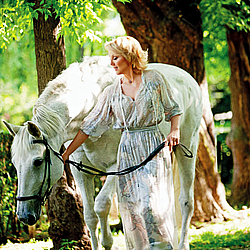Lepa Brena Biography
Official YouTube channel: http://youtube.com/LepaBrenaVEVO Born Fahreta Jahić in Tuzla (grew up in town Brčko of Bosnia) on October 20, 1960, Lepa Brena is arguably the most well-known and successful singer from the region of former Yugoslavia. She and her band Slatki Greh ("Sweet Sin") were the first to combine traditional Yugoslav folk music (in particular, the traditional "kolo" dance) with modern pop elements, and went on to inspire and influence an entire generation of musicians. Songs such as "Mile voli disko" (1982), "Miki, Mićo" (1985) and "Čik pogodi" (1990) are amongst the most well-known and popular songs in the history of Serbo-Croatian language music, and are definitive of the music of that era. Lepa Brena and her band "Slatki Greh" formed in 1982, gaining immediate success with their first album, which featured the hits "Čačak, Čačak," and "Ljubi me, Omere." The Yugoslav public quickly fell in love with the 21-year-old singer. That success promptly reached unexpected heights with the release of their second album later that year, delighting the folk-loving masses with the enormous hits "Mile voli disko," "Duge noge" and "Dama iz Londona." They also achieved success with the song "Sitnije, Cile, sitnije," a contender for Eurovision '83. In 1984 Brena returned with a new album and hit song "Bato, Bato." Her sexy new image, along with the band's more refined musical style, took her to even greater levels of stardom. They toured relentlessly in support of the album, which also spawned the hits "Bosanac," "Igraj Boro, moje oro" and "Moj je lola zvezda roken rola," amongst others. By now, the ensemble had become renowned for their catchy pop-folk stylings and fun lyrics (the object of Brena's affection in "Moj je lola..." is an Elvis Presley wannabe, whose obsession with rock music forces her to proudly declare her devotion to traditional folk: "Waltz? NO! Disco? NO! Kolo? YES!"). Over the course of the next three years, another three albums would follow, which collectively featured the hits "Šeik," "Mače moje," "Nežna žena," "Miki, Mićo," "Okrećeš mi leđa" and many more. In addition to these albums, she also teamed up with fellow singer, Miroslav Ilić, to record four duets, including the romantic "Jedan dan života." The highly successful collaboration also featured "Živela Jugoslavija," which was equally hated as much as it was loved, due to its overtly political subject matter (Brena made no attempt to hide her support of a united Yugoslavia, despite the sensitivity of the issue). This controversy, however, did not deter the star from performing the song at the opening ceremony of the 1984 Winter Olympics in Sarajevo. By the end of 1986, Lepa Brena had become the most famous person in all of Yugoslavia, and had also well and truly cemented her status as a sex symbol. This success, however, showed no sign of waning, and in 1987 she continued to dominate popular culture with the release of her movie "Hajde da se volimo" ("Let's Love Each Other"), which featured songs from her album of the same name. With this release, her musical style took a gigantic leap forward, the songs containing a much more modern edge and stylish pop-infused production, without abandoning their traditional folk roots. The project was so successful that she went on to film parts 2 & 3 (in 1988 and 1990), each in support of a new album. This string of LP's produced an extraordinary number of hit songs, including "Hajde da se volimo", "Golube," "On ne voli me," "Udri Mujo," "Biseru beli," "Ja pripadam samo tebi," "Zaželi sreću drugima," and "Čik pogodi." In addition to these was the beautiful "Jablane," written by Dino Merlin (a hugely successful singer/songwriter) as well as "Jugoslovenka," another controversial collaboration, this time with three male singers, each from different parts of Yugoslavia (Alen Islamović, Vlado Kalember and Danijel Popović). After releasing yet another album, "Zaljubiška," in 1991, Brena took a well-earned break from her hectic touring and recording schedule, leaving war-torn Yugoslavia to start a family with new husband, tennis player Slobodan Živojinović in the United States. She returned to audiences in 1994 with a highly successful solo album (her first without Slatki Greh), which featured one of her biggest hits to date, "Ja nemam drugi dom" ("I Have No Other Home"). The song, her personal favourite, is a touching ode to her first son, Stefan, and also (one would suspect) a reference to the disintegration of her beloved homeland ("I have no other home, but the home inside your heart"). Two more solo albums followed; "Kazna Božija" (1995) and "Šta je bilo, bilo je," (1996) the latter featuring the songs "Luda za tobom" and "Ti si moj greh," which would become two of the most successful songs of her career. After another three-year hiatus, the year 2000 saw Lepa Brena reuniting with "Slatki Greh" for one last project, an upbeat collection of songs, reminiscent of their earlier material. After 8 years absence from showbiz, Lepa Brena returned in 2008 with album "Uđi slobodno...". New album was released on 29 June 2008. It contains 10 new songs, nine written by Brena's old song-writer Marina Tucaković and Aleksandar Milić Mili. A total of 300,000 copies sold. Album contains hits: Uđi Slobodno, Pazi kome zavidiš, Kuća Laži... 16th Lepa Brena album was released in presale on 20th July 2011, while the regular sale starts on 20th August 2011. The album includes nine songs. Its first edition was printed in 200,000 copies. Albums lead single "Metak sa posvetom" was written by Petar Grašo.... Her song "Čik pogodi" has a Romanian version sung by Adrian Copilul & Stana Izbasa and a Remix with all three. Today she lives in Belgrade, Serbia.
Top Lepa Brena Lyrics
Write a comment
What do you think about Lepa Brena? Let us know in the comments below!




















